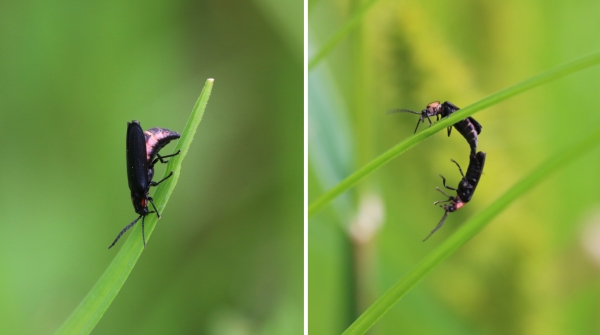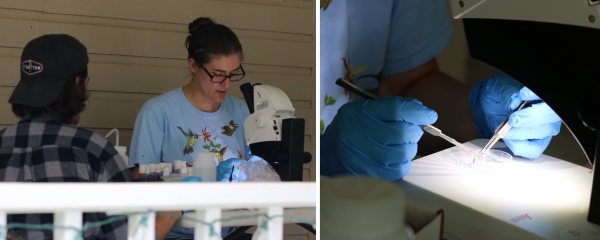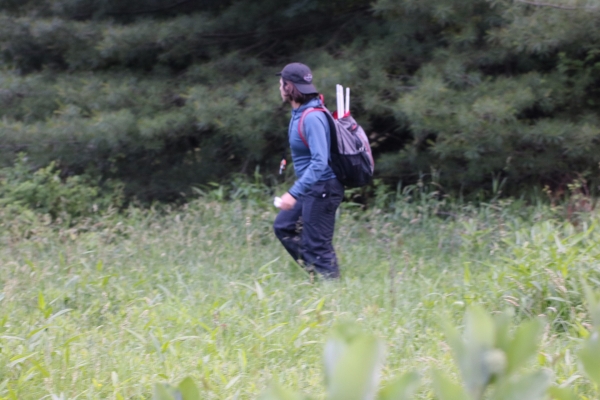I saw some “lightning bugs” one evening in later July in my backyard. I was thrilled, some lights were much larger than others and I was curious about that.
Firefly Research at Shelburne Farms
A Q&A with Dr. Sarah Lower
Assistant Professor of Biology, Bucknell University
Sarah Lower, along with several research assistants, conducted firefly research at the Farm over a week this July. We caught up with her to ask her a few questions about her work.
What brought you to Shelburne Farms to research fireflies?
My research students and I visited Shelburne Farms on a quest for a specific species - the Ignited Firefly (Photinus ignitus). This species is relatively common in the northeastern United States and can be observed flashing over open pastures at night. These flashes are mating signals that they use to locate and choose mates. The ignited firefly is particularly interesting because its most closely related species, P. indictus, is a “dark” firefly. This means that, unlike the ignited fireflies, P. indictus adults have no lanterns, do not flash, and are active during the day. Instead of light, P. indictus use chemicals (pheromones) to find mates. By comparing the gene sequences of these two species, we can learn more about how and why these contrasting mating signal strategies (light versus chemical) occur. My students and I were not able to locate any areas with ignited fireflies near Bucknell’s campus in central Pennsylvania, so I went through my collection records from the past 10 years to see where I had found some previously. In 2012, I collected a couple of ignited fireflies in South Hero, Vermont, but there weren’t that many individuals, perhaps because the habitat was wooded and not pastureland. When I was in the area in 2012, I had also visited Shelburne Farms as a tourist and noted the ideal habitat conditions for the ignited firefly. Based on this, I hoped that there might be even more ignited fireflies present and reached out to see if collecting on the property was a possibility.
What does your research involve?
My research involves observing and collecting fireflies of different signal types (light vs pheromones, different flash patterns), and analyzing their DNA sequences for clues as to how these different signals came to be. To do this, my research students and I spend the summer searching different habitats at different times of day for different firefly species. During their day, we walk along trails in fields or forest and examine every leaf and blade of grass for a firefly. At night, we use stopwatches to time the flashing patterns of each individual we capture so we can use the information later on to identify the species. We take these individuals back to the lab and identify them using a combination of what they look like under a microscope, their behavior (day vs night activity, habitat, flash pattern), and their DNA sequences. Once we are sure an individual is a species that we are interested in, we process the sample for futher genetic analysis, either by sequencing its genome (the entire genetic make-up of the firefly), or only sequencing the genes that are turned on in a specific tissue at a specific time. This results in a lot of data (some fireflies have a genome that is almost as big as humans!), so we take advantage of Bucknell’s supercomputer to look for patterns that indicate which genes may be involved in a particular signal type.
What did you discover while you were here?
At Shelburne Farms we discovered five day-active species and at least five nocturnal species, which we are still working to confirm. Fireflies were active in both woods and fields, though most of the nocturnal species were happily flashing above the pastures and the margins where fields meet woods. One particularly spectacular sight was exploring the mowed paths around the field at Windmill Hill just after sunset. Because the path takes you among the tall grasses and hedgerows, you are surrounded by firefly flashes on all sides. If you take a moment to stop and observe the flashes, you can see all five different flash patterns of the nocturnal species, from single flashes to five flickering flashes in a row, all in one area!
Is there anything special about Shelburne Farms fireflies?
Shelburne Farms fireflies are special because you can see so many different species in one place at one time. We were excited to find the particular species in which we were interested in high numbers. We even found females, which are often difficult to find because they are more hidden than the more flashy males. Unexpectedly, we found P. indictus, the day-active relative of the ignited firefly as well!
How do you tell firefly species apart?
We tell the day-active species by when we observe them flying (day or night), and, if you flip them over to look at their abdomen, they lack the well-developed light organs of their night-active relatives. Within day-active species, we can generally tell them apart by size. For nocturnal species, it is essential that we know the flash pattern of each individual we catch so we can identify the species (e.g. one flash every five seconds, two flashes every 4 seconds). We also look at the shape of the firefly, what color it is on its back and underside, and the shape of some internal organs.
Can you share one cool fact about fireflies?
Fireflies, also known as lightning bugs, are neither flies nor bugs! They are actually beetles, in the family Lampyridae. One of their defining characteristics is that they all light up in their juvenile form, even though some species do not have light as adults. [Find more cool firefly facts from Prof. Lower.]
What happens next with your research?
This fall we will be sequencing the genes of the light-using, night-active and chemical-using, day-active species to see if we can identify the genes involved in these very different mating signal types.
Read more about Sarah's research.
Comments
Nancy, I had the same experience. My sister who was visiting noticed them first--said they were much larger, moved and blinked much faster than "regular" fireflies. I thought she must have imagined it, but a few days later, I saw them, too, about three of them in the yard. I asked a naturalist friend who directed me to this post. Did you get any info?


